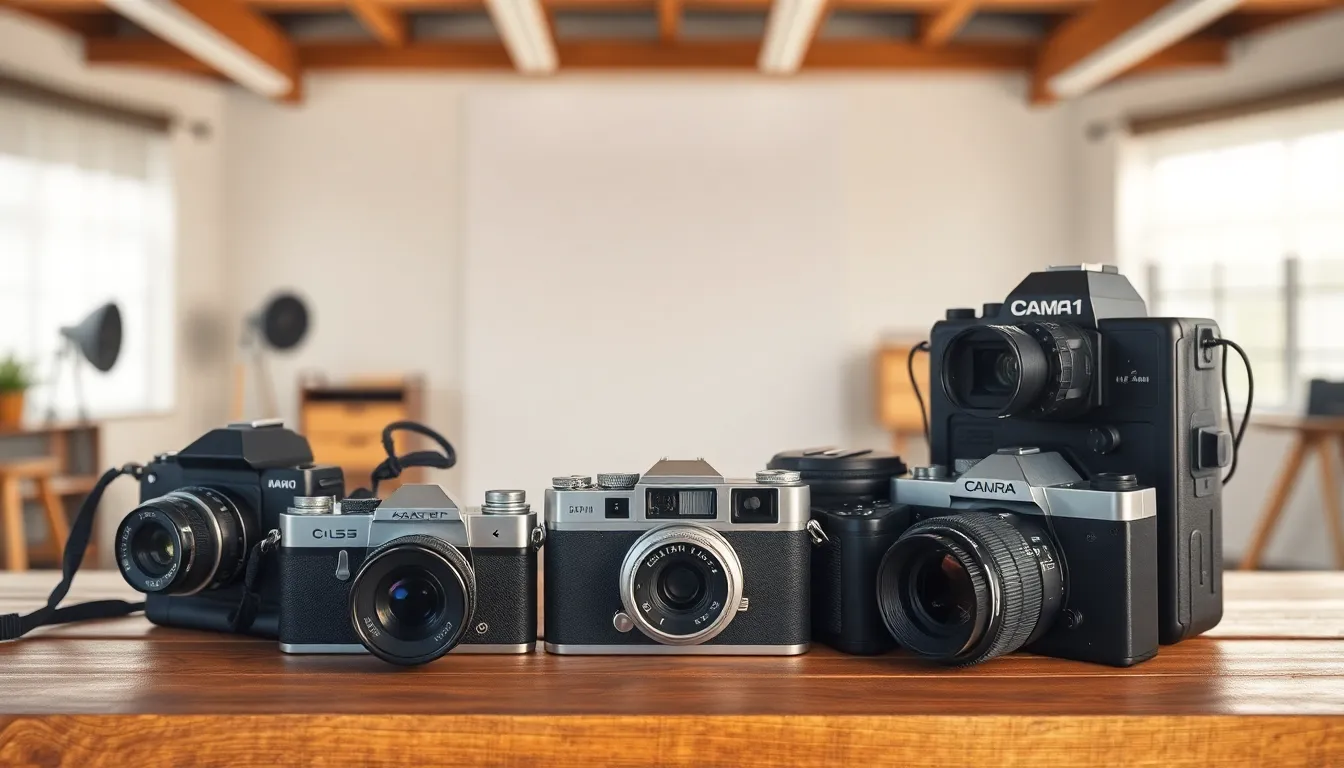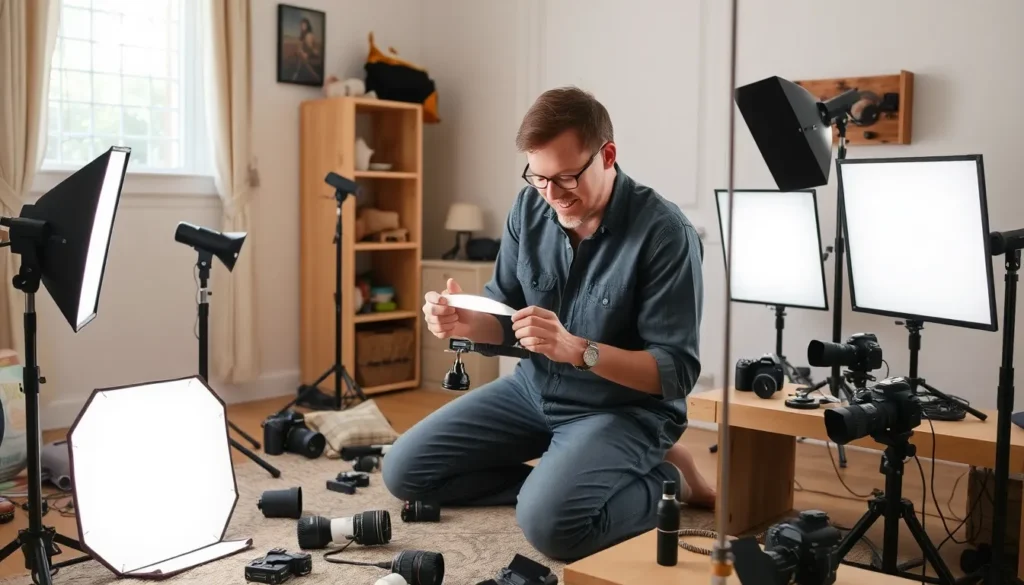In a world dominated by digital images, analog photography stands out as a timeless art form that captures moments with a unique charm. This traditional method, relying on film and manual techniques, evokes nostalgia and a sense of authenticity that many modern photographers crave. With each click of the shutter, photographers embrace a slower, more deliberate process, allowing them to connect deeply with their subjects.
As the resurgence of analog photography gains momentum, enthusiasts are rediscovering the beauty of grainy textures and rich colors that only film can deliver. From vintage cameras to darkroom development, this medium offers a tactile experience that digital photography often lacks. Whether it’s a hobby or a serious pursuit, analog photography invites individuals to explore their creativity in a refreshing way, reminding them of the magic found in each frame.
Table of Contents
ToggleOverview Of Analog Photography
Analog photography captures images on film rather than through digital sensors, creating a tangible link to photographic history. Its unique qualities and processes attract a dedicated community of enthusiasts.
Definition And History
Analog photography involves capturing images using film-based cameras. The process began in the early 19th century with pioneers like Joseph Nicéphore Niépce, who created the first permanent photograph in 1826. Over decades, various film formats emerged, including 35mm, medium format, and large format. The introduction of color film in the mid-20th century further broadened its appeal. While digital photography surged in popularity in the late 1990s and early 2000s, analog photography maintains a devoted following, rooted in its rich history and artistic value.
Key Characteristics
Analog photography is defined by its distinctive traits, including:
- Film Types: Various film options exist, such as black and white, color negative, and slide film. Each type produces different aesthetic results.
- Texture and Grain: Film captures images with organic textures and grain patterns, which contribute to the overall character of photographs.
- Dynamic Range: Film exhibits a high dynamic range, allowing for subtle color gradations and details in highlights and shadows.
- Processing Methods: Developing film requires specific chemical processes, enabling photographers to engage with their images beyond just capture.
- Cameras: Vintage and modern analog cameras include rangefinders, SLRs, and point-and-shoot models, each providing unique shooting experiences.
These characteristics create an experience for photographers that encourages exploration and fosters creativity.
Types Of Analog Cameras

Various types of analog cameras cater to different photographic needs and styles. Understanding these types helps photographers choose the right equipment for their artistic vision.
Film Cameras
Film cameras utilize photographic film to capture images. They come in several formats, each offering distinct characteristics:
- 35mm Cameras: The most popular type, 35mm cameras are versatile and widely used for casual and professional photography. They typically feature interchangeable lenses and automatic settings.
- Medium Format Cameras: Medium format cameras use larger film (typically 120 or 220) for a more substantial image quality and detail. They are favored for portrait and landscape photography.
- Point-and-Shoot Cameras: These compact cameras are easy to use, featuring automatic settings. They attract casual photographers who prefer simplicity without sacrificing image quality.
- Rangefinder Cameras: Known for their precise manual focusing, rangefinder cameras appeal to street photographers and those seeking a more hands-on experience.
Large Format Cameras
Large format cameras accommodate film sizes typically 4×5 inches or larger, providing exceptional detail and image quality. Key features include:
- Sheet Film: Large format cameras use individual sheets of film, allowing precise control over exposure and composition.
- Flexibility and Control: With extensive movements (tilt, shift, and swing), large format cameras allow photographers to manipulate perspective and focus easily, making them ideal for architectural and landscape photography.
- Standing Format: These cameras often require a tripod for stability, emphasizing the intentional approach to photography associated with large format techniques.
Each type of analog camera presents unique opportunities and challenges, catering to the diverse preferences and objectives of photographers.
The Process Of Shooting With Film
Shooting with film requires a hands-on approach that emphasizes patience and precision. The following processes enhance the experience and outcome of analog photography.
Loading The Film
Loading film into a camera involves careful steps to ensure proper exposure and functionality. Photographers start by opening the camera back, removing any old film, and inserting a new film roll into the designated compartment. They then pull the film leader across to the take-up spool and secure it. It’s crucial to advance the film a few frames to confirm proper loading. Once complete, photographers close the camera back, ensuring the film is dark and secure during shooting.
Exposure Techniques
Exposure techniques are vital for capturing the desired image qualities in film photography. Photographers utilize the camera’s exposure settings, determining the appropriate aperture, shutter speed, and ISO based on lighting conditions. The exposure triangle—aperture, shutter speed, and ISO—creates a balanced image when adjusted correctly.
- Aperture: Adjusting the lens opening affects depth of field and brightness.
- Shutter Speed: Selecting a shutter speed controls motion blur and light capture.
- ISO: Choosing the film’s sensitivity determines how it reacts to light.
Photographers often experiment with exposure settings to achieve unique results, such as overexposed or underexposed images, enhancing the creative aspect of film photography.
The Development Process
The development process of analog photography involves several crucial stages that transform captured images on film into visible photographs. Understanding these steps enhances appreciation for the intricacies of film photography.
Chemical Development
Chemical development is the core process that reveals latent images on film after exposure. Photographers immerse film in a series of chemical baths, each serving a specific purpose.
- Developing Solution: The film undergoes a developing solution, which reduces exposed silver halide crystals to metallic silver, forming an image.
- Stop Bath: After development, the film enters a stop bath, neutralizing the developer to halt the development process.
- Fixer: The fixer removes any unexposed silver halide, rendering the image permanent and safe from light exposure.
- Washing: Finally, washing the film in water removes residual chemicals, ensuring longevity and image clarity.
The entire process typically takes around 30 minutes, depending on the film type and desired results.
Scanning And Printing
Scanning and printing allow photographers to produce physical or digital copies of their developed images.
- Scanning: Photographers can digitize negatives using flatbed or dedicated film scanners. Scanning converts the film into digital files, making it easier to edit and share images online.
- Printing: Photographers can choose from various printing techniques, such as enlargements on photographic paper or inkjet printing. Each method offers different quality levels and aesthetic results, depending on the materials and printing technology used.
Typically, printing involves using enlargers to project light through the negative onto light-sensitive paper. The resulting print undergoes chemical development, mirroring the film development process to ensure consistent and high-quality results.
Benefits Of Analog Photography
Analog photography offers unique benefits that attract both seasoned photographers and newcomers alike. The distinctive qualities of film create an engaging and rewarding experience.
Aesthetic Qualities
Analog photography showcases rich aesthetic qualities that digital methods often lack. Film captures organic textures, grain patterns, and a color depth that add warmth to images. Photographers appreciate how each film type influences the final results, with variations in contrast, saturation, and tonal range. For example, black-and-white film highlights dynamic contrasts, while color film can evoke nostalgia through pastel hues or vibrant colors. This diversity in visual output fosters creativity by allowing artists to choose specific films that align with their artistic vision.
Tangibility And Experience
Analog photography emphasizes the tangible experience of capturing images. Photographers hold physical film rolls, interact with vintage cameras, and engage in the hands-on process of developing photographs. This tactile interaction fosters a deeper connection to the craft and enhances photographic skills. The physical process reinforces the significance of each shot, as each image represents a deliberate choice. Additionally, the act of developing film in a darkroom or waiting to see prints unveils a sense of anticipation that digital methods lack. This commitment to the process encourages photographers to slow down, think critically, and savor their artistic journey.
Challenges And Limitations
Analog photography presents several challenges and limitations that photographers encounter in their creative journey. Understanding these obstacles helps enthusiasts navigate the medium effectively.
Cost And Accessibility
Cost represents a significant barrier for many analog photographers. Film, processing, and printing expenses accumulate quickly. Purchasing high-quality film can cost between $5 to $20 per roll, while developing costs approximate $10 to $20, depending on the lab. In comparison, digital photography requires only an initial investment in equipment.
Accessibility poses further challenges. Finding local labs for developing and printing can be difficult, particularly in areas with fewer photographic services. This situation restricts enthusiasts to online services, which can lead to longer wait times for processed films. Limited access to specific film types may further hinder photographers, as certain films may go out of production or be hard to find.
Learning Curve
The learning curve for analog photography can prove steep for newcomers. Mastering techniques such as manual exposure settings, film types, and developing processes demands time and practice. Photographers must understand how to achieve proper exposure, including manipulating aperture, shutter speed, and ISO. Each decision shapes the image’s final outcome, increasing the importance of skill development.
Developing film also requires knowledge of chemical processes. Photographers often spend hours in the darkroom, learning to mix solutions and time each phase accurately. Mistakes during these stages can lead to ruined images, emphasizing the need for meticulousness. The combination of these factors means that mastering analog photography entails a commitment to ongoing learning and practice.
Analog photography continues to captivate both seasoned photographers and newcomers alike. Its unique charm lies in the tactile experience and the artistic journey it offers. Each step from loading film to developing images fosters a deeper connection to the craft.
Despite the challenges posed by costs and accessibility, the rewards of shooting with film often outweigh the difficulties. The rich textures and colors of film create images that resonate on a personal level. As the popularity of analog photography grows, it reaffirms the value of slowing down and savoring the art of capturing moments. This enduring medium not only preserves history but also inspires creativity in an increasingly digital world.



